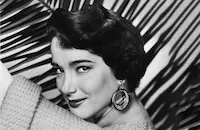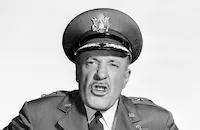Hollywood Story
Brief Synopsis
Cast & Crew
William Castle
Richard Conte
Julia Adams
Richard Egan
Henry Hull
Fred Clark
Photos & Videos
Film Details
Technical Specs

Synopsis
Talent agent Mitch Davis brings his old friend, New York theatrical producer Larry O'Brien, to the National Artists Studios, an abandoned movie studio, where Larry plans to make his first Hollywood film. As soon as the elderly guard, John Miller, shows them the office of famed silent film director Franklin Ferrara, Larry becomes intrigued with the idea of making a movie about Ferrara's still-unsolved murder. Against Mitch's advice, the producer throws himself into researching the murder, and tracks down and hires Ferrara's old writer, Vincent St. Clair. Soon, all of Hollywood is buzzing about the story, and the old studio is once again bustling with activity and the presence of old-time silent film stars Larry has cast. One night, Larry goes over his notes about the murder, which reveal that Ferrara had three visitors on the night he was killed: stars Amanda Rousseau and Roland Paul, and Ferrara's personal secretary Charles Rodeo, who was rumored to be Ferrara's brother, and who disappeared following the murder. Just after Lt. Bud Lennox arrives to offer Larry help if trouble occurs, Larry's financial backer, Sam Collyer, bursts in and demands that Larry cancel the film. When Larry demurs, Sam storms out, but later apologizes and pledges his support. As Larry works late that night, someone shoots at him through the office window. Immediately afterward, Amanda's daughter, Sally Rousseau, arrives to implore Larry to drop the picture in order to protect her mother, and as he leaves the office, he glimpses her with Paul. When he questions her the next morning, Sally reveals that, although most people assume that Paul killed Ferrara, she does not believe it. Larry continues his research and learns that Sam was Ferrara's business partner and once fired St. Clair for poor writing. He then receives a call from Rodeo offering information on Ferrara's murder, and before he visits, asks Sally to call the police if he does not return quickly. As he enters the hotel room, Larry is knocked out by an unseen assailant, and when he comes to, he finds Rodeo's dead body next to him clutching a note reading "GR1466." When Larry visits Paul the next day to question him about Rodeo, Lennox is already there to arrest Paul, who escapes. Soon after, Sally reveals that Paul is her father, and that his marriage to her mother, which was kept a secret for publicity reasons, ended when Amanda fell in love with Ferrara. Larry returns to his office, where he discovers that "GR1466" was Sam's old phone number. Then, noticing a hole in the nickelodeon piano roll, he unrolls it and finds the .32 caliber bullet that killed Ferrara. Knowing that Sam has a gun of the same caliber, he confronts his partner, who admits that Ferrara was killed with his gun. Sam then describes how he was framed for the murder: Someone steals Sam's gun, and when Ferrara phones him in a panic, Sam runs to his office, only to find him dead and Sam's love letters to Amanda on his desk. In the present, Sam tells Larry that he kept quiet about the murder because he thought Amanda had killed the director, and then gives Larry the family medallion which Ferrara had been clutching when he died. Larry brings the medallion to a priest and calls Lennox, Sally and St. Clair to his office. There, Larry reveals that Ferrara's brother Phillip murdered Ferrara and then killed Rodeo so he would not be identified. When he explains that the figure on Ferrara's medallion is St. Clair, the family's patron saint, St. Clair draws a gun. Larry deduces that St. Clair, who could not write, killed his brother out of jealousy, and pinned the murder on Sam, who had insulted him. St. Clair shoots Lennox and leads Larry on a chase through the studio, which culminates when Larry shoots him. St. Clair dies in the same spot as his brother did twenty-one years earlier. Months later, Larry's movie is a hit, as is his wedding to Sally.

Director

William Castle
Cast

Richard Conte

Julia Adams

Richard Egan

Henry Hull

Fred Clark

Jim Backus

Francis X. Bushman
Betty Blythe

William Farnum
Helen Gibson
Houseley Stevenson

Paul Cavanagh
Katherine Meskill
Louis Lettieri

Joel Mccrea

Peter Brocco
June Whitley
Jean Mills
Russell Dennis
William Vedder
Marjorie Eaton
Harris Brown
Olan Soule
Joe Mell

Eddie Kane
Forbes Murray
Douglas Evans
Anthony Barr
John Crawford
Charles Sullivan
Charles Gibb

Robert R. Stevenson
Robert Sherman
Rico Alaniz
William Fawcett
Joseph Bryan
Jimmy Gray
Allen O'locklin
Jim Casino
Bill Marks

Gloria Petroff
Jack Reynolds
Charles Sherlock
Crew
Andy Anderson
Fred Brady
Leslie I. Carey
Russell A. Gausman
Joseph Gershenson
Leonard Goldstein
Bill Grady Jr.
Carl Guthrie
Julia Heron
Bernard Herzbrun
Frederick Kohner
Rosemary Odell
Richard H. Riedel
Ronnie Rondell
Joan St. Oegger
Virgil Vogel
Bud Westmore

Photo Collections
Film Details
Technical Specs

Quotes
Trivia
Notes
The title card reads: "Richard Conte Hollywood Story." The story of "Franklin Ferrara's" death was inspired by the unsolved murder of director William Desmond Taylor. Taylor, who claimed to be born in 1877 in Ireland, first acted in films and then became famous as a Paramount director and president of the MPPDA. Taylor was shot in his study on November 1, 1922. Modern sources allege that studio executives, already reeling from the scandal of the Roscoe "Fatty" Arbuckle murder trial, conspired to hide evidence in order to avoid the revelation of Taylor's rumored bisexuality and alcohol and drug abuse.
Two actresses, Mary Miles Minter and Mabel Normand, were romantically linked to the director and had visited him on the night of his death, and both saw their careers ruined as a result of the case. Like Hollywood Story, Taylor's brother, Denis Deane-Tanner, renamed himself Sands and posed as Taylor's butler after larceny charges were brought against him. Deane-Tanner disappeared after Taylor's death and was never found by the police. Although over three hundred people confessed to the killing and numerous articles and books analyzed the case, no charges were ever brought against anyone and the murder remains unsolved.
Hollywood Story marked actor Richard Conte's first film under a non-exclusive contract to Universal-International. Actor Joel McCrea made an uncredited cameo as himself in a scene in which "Larry" visits a film set. In another scene, Larry screens a clip of a film and identifies it as a "Franklin Ferrara" picture, but the clip is actually from the 1925 Universal film The Phantom of the Opera, featuring Lon Chaney and Mary Philbin. Another clip was created specifically for Hollywood Story but made to look like a silent-era picture. According to a December 15, 1950 Hollywood Reporter news item, in addition to Francis X. Bushman, Betty Blythe, William Farnum and Helen Gibson, the following silent stars were cast in the film: Herbert Rawlinson, Richard Neill, Arlene Pretty, Cleo Ridgeley, Dorothy Vernon, Elmo Lincoln, Spec O'Donnell, Stewart Holmes, Hank Mann, Babe Kane and Marie Osborne. Their appearance in the final film, however, has not been confirmed.
A studio press release states that a variety of Los Angeles area locations were used to add to the film's realism, including the Trocadero nightclub, Ocean Park Pier in Santa Monica, the Los Angeles Times building, Lockheed Air Terminal, the Motion Picture Relief Home, Beverly Hills, the Roosevelt Hotel, Grauman's Chinese Theatre and the Sunset Strip. San Juan Capistrano was also used as a location. The scenes which take place at Ferrara's studio scenes were shot in the Chaplin Studios on La Brea Avenue. Hollywood Reporter news items reported several publicity tie-ins at the time of the film's release, including a talent search on the ABC television program "Hollywood Screen Test"; a campaign in which department stores exhibited movie memorabilia; and a preview of the film hosted by Jack Benny.












